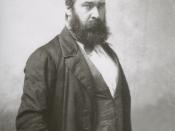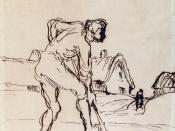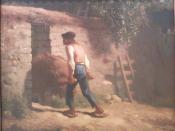The title of my art focused upon in this paper is The Angelus, by Jean-Francois Millet. Millet painted this work of art in 1951. I chose this painting because of Millet's fascination with the peasant life. Most of the art before the French realism focused on portraying the wealthy aristocrats and biblical imagery and stories, but now we are beginning to see everyday people and even peasants being portrayed in art work. Another thing that fascinated me with this particular artist is his subjects anonymously. I came across two portraits one was titled Portrait of a Man and the other was titled Portrait of a Woman. No Wealthy or royalty, just ordinary everyday individuals. Jean Francois Millet was born into a family of peasant farmers near Cherbourg. He trained locally as a painter and then went to Paris in 1837 to study under Delaroche. His early work comprised of conventional portraits and fashionable eighteenth century pastoral scenes.
However, in 1848 he chose to exhibit The Winnower, a painting depicting peasant life, at the Paris Salon. It was the first of many rural scenes based on memories of his own childhood (Archive.com, 2005). It was pleasant for me to see Millet shy away from the conventional subjects in painting, and paint about his childhood and how it was for him growing up destitute. The Angelus, is the epitome of what realism art represents. His artwork depicts what he himself known or seen because he grew up a peasant farm worker and most of his works of art is about nature because most of them that I saw were painted in the outside in the fields. Jean-François Millet was a great painter of peasants was he himself began life as a tiller of the soil, and he never lost touch with...


